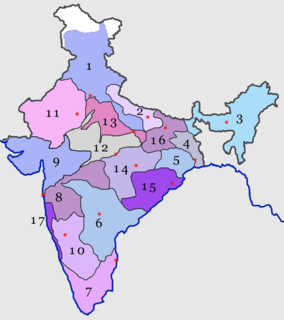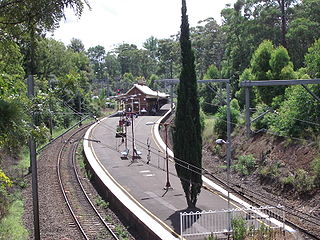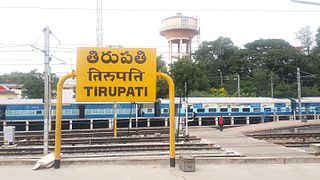
The London Underground is a rapid transit system serving Greater London and some parts of the adjacent counties of Buckinghamshire, Essex and Hertfordshire in England.

A railway platform is an area alongside a railway track providing convenient access to trains. Almost all stations have some form of platform, with larger stations having multiple platforms.

Central is a heritage-listed railway station located in the centre of Sydney, New South Wales, Australia. The station is the largest and busiest railway station in Australia and serves as a major transport interchange for NSW TrainLink inter-city rail services, Sydney Trains commuter rail services, Sydney light rail services, bus services, and private coach transport services. The station is also known as Sydney Terminal. The property was added to the New South Wales State Heritage Register on 2 April 1999. It recorded 85.4 million passenger movements in 2018.

Indian Railways (IR) is a statutory body under the ownership of Ministry of Railways, Government of India that operates India's national railway system. It manages the fourth largest national railway system in the world by size, with a total route length of 68,103 km (42,317 mi) as of 31 March 2022. 52,247 km (32,465 mi) or 83% of all the broad-gauge routes are electrified with 25 kV 50 Hz AC electric traction as of 1 April 2022.

Beijingxi railway station, colloquially referred to as West Station, is located in western Beijing's Fengtai District. Opened in early 1996 after three years of construction, it was the largest railway station in Asia with an area of 510,000 m2, before being surpassed by Shanghai Hongqiao railway station in platform capacity. The station serves in average 150,000–180,000 passengers per day with a maximum of 400,000 people per day. It was expanded in 2000 and had a large number of parking spaces added.

The Western Railway is one of the 19 zones of Indian Railways and is among the busiest railway networks in India, headquartered at Mumbai, Maharashtra. The major railway routes of Indian Railways which come under Western Railways are: Mumbai Central–Ratlam, Mumbai Central–Ahmedabad and Palanpur–Ahmedabad. The railway system is divided into six operating divisions: Ahmedabad, Vadodara, Rajkot, Bhavnagar, Ratlam, and Mumbai WR. Vadodara railway station, being the junction point for the Ahmedabad–Mumbai route and the Mumbai–Ratlam route towards New Delhi, is the busiest junction station in Western Railways and one of the busiest junctions of Indian Railways too, while Ahmedabad Division earns highest revenue followed by Mumbai Division and Vadodara Division. Surat railway station is one of the busiest railway station in Western Railway in non-junction category where more than 180 trains pass per day.

An island platform is a station layout arrangement where a single platform is positioned between two tracks within a railway station, tram stop or transitway interchange. Island platforms are popular on twin-track routes due to pragmatic and cost reasons. They are also useful within larger stations where local and express services for the same direction of travel can be provided from opposite sides of the same platform thereby simplifying transfers between the two tracks. An alternative arrangement is to position side platforms on either side of the tracks. The historical use of island platforms depends greatly upon the location. In the United Kingdom the use of island platforms is relatively common when the railway line is in a cutting or raised on an embankment, as this makes it easier to provide access to the platform without walking across the tracks.

A side platform is a platform positioned to the side of one or more railway tracks or guideways at a railway station, tram stop, or transitway. A station having dual side platforms, one for each direction of travel, is the basic design used for double-track railway lines. Side platforms may result in a wider overall footprint for the station compared with an island platform where a single width of platform can be shared by riders using either track.

The Northern Railway (NR) is one of the 19 Railway zones of India and the northernmost zone of the Indian Railways. It is headquartered at the Baroda House in New Delhi.

Puratchi Thalaivar Dr. M.G. Ramachandran Central Railway Station, commonly known as Chennai Central, is the main railway terminus in the city of Chennai, Tamil Nadu, India. It is the busiest railway station in South India and one of the most important hubs in the country. It is connected to Moore Market Complex railway station, Chennai Central metro station, Chennai Park railway station, Chennai Park Town railway station and is 2 km from Chennai Egmore railway station. The terminus connects the city to northern India, including Kolkata, Mumbai, New Delhi as well as to Bangalore, Ahmedabad, Guwahati, Chandigarh, Kerala,Hyderabad and different parts of India.

Hazrat Nizamuddin railway station is a railway station in South Delhi, India. It is under the administrative control of the Delhi Division of the Northern Railway zone of the Indian Railways. It is one of the five main stations in Delhi and handles nearly 250 trains daily The station was named after the Sufi saint, Hazrat Nizamuddin. Hazrat Nizamuddin station was upgraded to help relieve congestion at New Delhi railway station and is recommended for first time travellers, particularly those bound for Agra as it much quieter and easier to navigate.

Rapid transit or mass rapid transit (MRT), also known as heavy rail or metro, is a type of high-capacity public transport generally found in urban areas. A rapid transit system that primarily or traditionally runs below the surface may be called a subway, tube, or underground. Unlike buses or trams, rapid transit systems are railways that operate on an exclusive right-of-way, which cannot be accessed by pedestrians or other vehicles, and which is often grade-separated in tunnels or on elevated railways.

Varanasi Junction railway station, also known as Varanasi Cantt railway station, is the main railway station serving the city of Varanasi. The other key railway stations in Varanasi Metro area are Banaras, Varanasi City, Pt. Deen Dayal Upadhyay Jn. and Kashi. The junction station is sandwiched between the cantonment region and Chetganj region of the city. The station is partially controlled by the Lucknow Division of the Northern Railway Zone and the Varanasi Division of the North Eastern Railway Zone of the Indian Railways. Varanasi Junction railway station nearly reaches the frequency of 300 trains daily. Almost, 45 trains originate and terminate at the station. Premium trains of Indian Railways also originate from Varanasi Junction, such as Vande Bharat Express and Mahamana Express

Vehari railway station is located in middle of the Vehari, Punjab, Pakistan. The station is staffed and has a booking office.

Vijayawada Junction railway station is an Indian Railways station in Vijayawada of Andhra Pradesh, categorized as a Non-Suburban Grade-2 (NSG-2) station in Vijayawada railway division. Situated at the junction of Howrah–Chennai and New Delhi–Chennai main lines, it is the fourth busiest railway station in the country after Howrah Junction, Kanpur Central and New Delhi. The station serves about 1.40 lakh passengers, over 190 express and 170 freight trains every day. It is one of the major railway junctions of the Indian Railways and is a nationally important halt.

A train station, railway station, railroad station or depot is a railway facility where trains stop to load or unload passengers, freight or both. It generally consists of at least one platform, one track and a station building providing such ancillary services as ticket sales, waiting rooms and baggage/freight service. If a station is on a single-track line, it often has a passing loop to facilitate traffic movements.

A station building, also known as a head house, is the main building of a passenger railway station. It is typically used principally to provide services to passengers. A station building is a component of a station, which can include tracks, platforms, an overpass or underpass, and a train shed.

New Delhi railway station is the main railway station in Delhi. Platform 1 is located at Paharganj and platform 16 opens up on to the side of Ajmeri Gate. The station is about two kilometres (1.2 mi) north of Connaught Place in Central Delhi. It is one of the busiest railway stations in the country in terms of train frequency and passenger movement.

Tirupati railway station is a railway station located in the Indian state of Andhra Pradesh. It serves Tirupati and experiences a regular flow of tourists visiting the Tirumala Venkateswara Temple in the Tirupati district. It is an environmentally friendly station, and has been awarded a Gold rating by the Indian Green Building Council. There are several railway stations that fall within the city limits of Tirupati, namely Tiruchanur, Renigunta Junction, Tirupati West Halt, and Chandragiri railway station.
Bhurgari railway station is located in Village Ghulam Nabi Bhurgri, Taluka Shahdadkot, District Qamber Shahdadkot District, Sind, Pakistan.

















